#Jacamar
Explore tagged Tumblr posts
Text

Green-tailed Jacamar (Galbula galbula), family Galbulidae, order Piciformes, Suriname
photograph by Eric van der Meer
877 notes
·
View notes
Text

Rufous-Tailed Jacamar (Galbula ruficauda)
Family: Jacamar Family (Galbulidae)
IUCN Conservation Status: Least Concern
Though somewhere between hummingbirds and kingfishers in appearance, jacamars like the Rufous-Tailed Jacamar are believed to be cousins of woodpeckers and have historically been placed alongside them in the order Piciformes, although more recent genetic evidence suggests that alongside their close relatives the puffbirds they may actually be distinct enough to warrant being reclassified as part of entirely new order, the Galbuliformes. Found mainly in forests and well-vegetated shrublands across northern South America and southern Central America, Rufous-Tailed Jacamars, like most members of their family, are agile insect-eaters that use their extremely long, narrow bills to catch small insects such as butterflies and wasps straight out of the air.
-----------------------------------------------------
Image Source: Here
#Rufous-Tailed Jacamar#jacamar#jacamars#bird#birds#zoology#biology#ornithology#wildlife#south american wildlife#north american wildlife
88 notes
·
View notes
Text
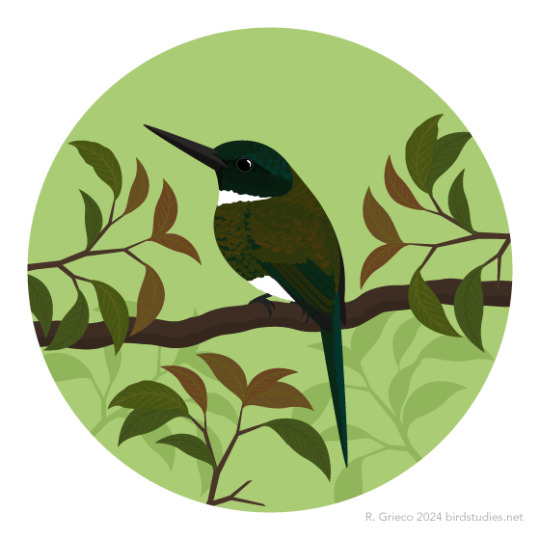
March 5, 2024 - Bronzy Jacamar (Galbula leucogastra) Found in parts of Bolivia, Brazil, Colombia, French Guiana, Guyana, Suriname, and Venezuela, these jacamars live in forests, savannas, shrublands, and wetlands. Foraging alone, in pairs, or in groups of up to four, they feed on flying insects, capturing prey in short flights from perches and occasionally joining mixed-species flocks. Only three of their nests have been described, two in arboreal termite nests and one in a bromeliad on a large tree trunk. Both parents fed the chicks at the first two nests though only the female fed them at the third.
87 notes
·
View notes
Text

#IFTTT#Flickr#poconé#matogrosso#brazil#raphaelkopanphotography#nikkor600f4evr#monopod#jacamar#birds#nature#z9#nikon
6 notes
·
View notes
Note
Trick or Treat! :D
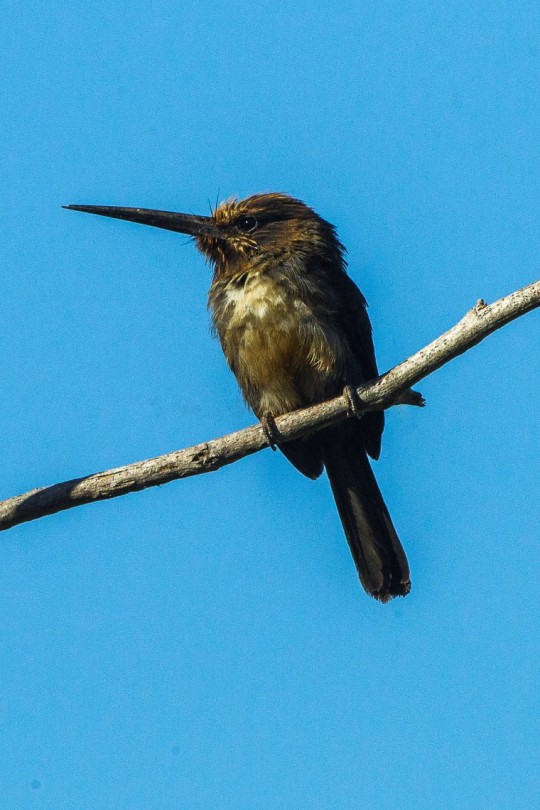
Three-Toed Jacamar!
Please do not send me more trick or treat asks, I am only answering the ones I could not get to after I hit post limit last night, it is Nov 1st we have other shenanigans to attend to!
22 notes
·
View notes
Text
BOTD: Rufous-tailed Jacamar
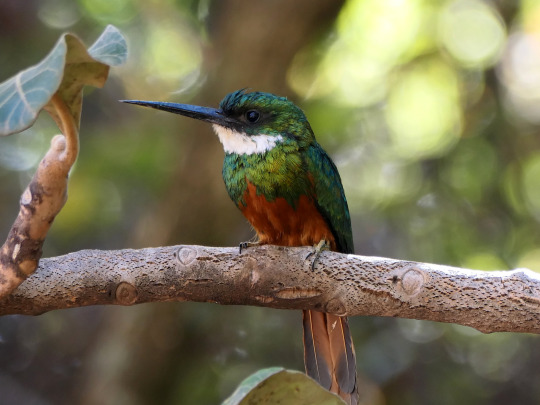
Photo: Egon Fink
"Handsome, slender, green-and-rusty bird of humid tropical lowlands. Lives in evergreen forest, often at edges and around adjacent clearings. Perches upright at mid-heights on vines or other exposed perches and sallies out for flying insects, especially butterflies, dragonflies, and wasps. Note the very long, slender black bill (like a giant hummingbird). Throat is white on male and buffy on female. Loud shrieking calls may draw attention."
- eBird
#birds#rufous tailed jacamar#birds of north america#north american birds#jacamar#jacamars#birds of mexico#birds of central america#birds of america#american birds#bird#birding#birdblr#birblr#bird watching#bird of the day#Galbula ruficauda
38 notes
·
View notes
Text
[Photo of a bird perched on a small bare branch. Its body is facing the camera and its head is turned to the side. Its plumage is extremely iridescent and metallic, mostly in shades of blue, with a bronze chest and nape, a white collar, and grey patches on the undertail. Its tail and beak are both long, thin, and pointed. It has small zygodactyl feet.]
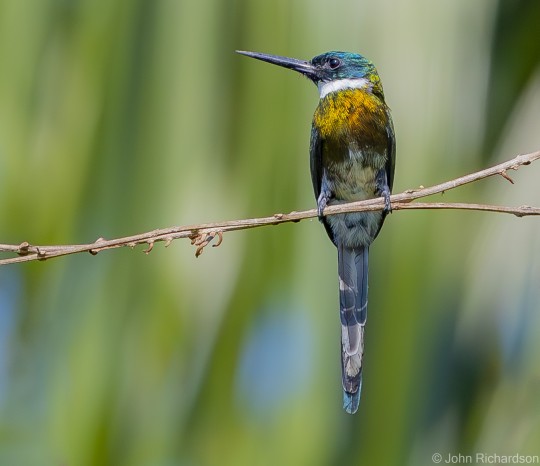
[1704/10977] Bronzy jacamar - Galbula leucogastra
Order: Piciformes Suborder: Galbuli Family: Galbulidae (jacamars)
Photo credit: John Richardson via Macaulay Library
#birds#jacamar#bronzy jacamar#Galbula leucogastra#Galbula#Galbulidae#Piciformes#Cavitaves#Telluraves#Neoaves#Neognathae#amazingly beautiful#my favourite yet#getting kingfisher vibes from this somehow#probably because of the metallic sheen#brb going to the park and sadly informing the kookaburras that we've been one-upped
110 notes
·
View notes
Note
a couple full frontal birds: https://macaulaylibrary.org/asset/624481356 & https://macaulaylibrary.org/asset/625594206
excellent finds!!

White-chinned Jacamar (Galbula tombacea)
© Stephan Lorenz

Slaty-backed Nightingale-Thrush (Catharus fuscater)
© Newt Wheeler
#white-chinned jacamar#galbula tombacea#galbulidae#piciformes#stephan lorenz#birds#slaty-backed nightingale-thrush#catharus fuscater#turdidae#passeriformes#newt wheeler
95 notes
·
View notes
Video
Ariramba-da-cauda-ruiva por silene andrade
#sileneandrade#Ariramba-da-cauda-ruiva#Arirambinha#Galbula ruficauda#Rufous-tailed Jacamar#Bird#Pássaro#nature#natureza#AltoParaísoDeGoiás#Nikon CORPORATION COOLPIX P1000#flickr
11 notes
·
View notes
Photo

A new variant has been added!
Purplish Jacamar (Galbula chalcothorax) © John Gerrard Keulemans
It hatches from blue, coppery, deep, eastern, few, golden, green, high, long, slender, and white eggs.
squawkoverflow - the ultimate bird collecting game 🥚 hatch ❤️ collect 🤝 connect
1 note
·
View note
Text
Fossil Novembirb: Day 13
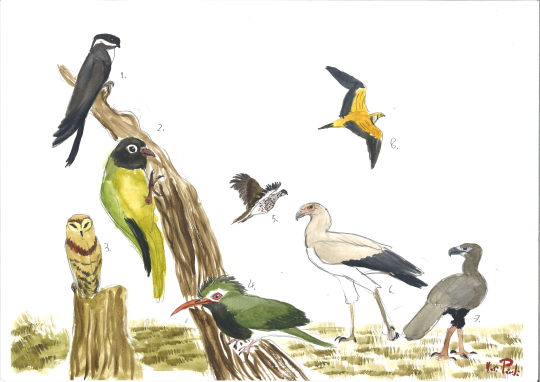
The phosphorate beds of Quercy, France preserve a wealth of fossils from the late Eocene and Oligocene epoch, about 35-25 million years ago. At that time, the early Paleogene jungle hothouse had ended. The climate was drying and cooling, and in parts of the world forests were giving way to savannah and scrubland, as was in Quercy. But that didn't stop birds. They started to take advantage of these new wide open spaces.
Aegialornis: An enigmatic bird that was closely related to swifts. Unlike swifts, it could perch and hold on to branches, but it was also an incredible flyer.
Quercypsitta: A unique group of not well known stem-parrots which likely resembled the earlier Halcyornithids, corvid-like stem-parrots from Europe and North America.
Palaeoglaux: Also known from the Messel Pit, this early relatively small owl may have been a diurnal hunter of small prey and had peculiar body feathers.
Sylphornis: A mysterious member of the piciformes with unique morphology, resembling jacamars and puffbirds.
Paraortyx: One of the earliest true phasianid galliforms, related to partridges, pheasants and chickens. It likely had a similar lifestyle to them, only taking flight when necessary.
Pelargopappus: An early relative of the long-legged secretarybird, this Eocene relative stalked the plains in a similar manner, stomping down on any prey it could catch.
Strigogyps: An omnivorous turkey-sized member of the cariamiform family, it is also known from the middle Eocene of Germany.
Archaeoganga: A relatively large and one of the earliest members of that wonderful desert bird clade, the sandgrouse.
#Fossil Novembirb#Novembirb#Dinovember#birblr#palaeoblr#Birds#Dinosaurs#Cenozoic Birds#Aegialornis#Quercypsitta#Palaeoglaux#Sylphornis#Paraortyx#Pelargopappus#Strigogyps#Archaeoganga
37 notes
·
View notes
Text


Rufous-tailed Jacamar (Galbula ruficauda), male, family Galbulidae, order Piciformes, Colombia
Photograph by Luis Gabriel Vinasco Sanchez
638 notes
·
View notes
Note
could I please suggest a bare-necked umbrellabird, a great jacamar, a crested ant tanager, a gilded flicker, an andaman woodpecker, a cinnamon bittern, and/or an indochinese roller when you're done w/ your drawing break?
Sure thing! It'll be in a random order but I appreciate having a list to go over when I can't come up with anything. I'll try to get to all these shortly after the break unless something comes up between now and then, in which they'll be in between other requests!
3 notes
·
View notes
Text

September 21, 2023 - Three-toed Jacamar (Jacamaralcyon tridactyla) These jacamars are found in southeastern Brazil in forests, often near streams and roads. They eat insects, hunting in short flights from perches in groups of two to ten. Breeding from September to February, they may nest in colonies and breed cooperatively. They excavate nest burrows in banks, often building several at the same time. Pairs incubate clutches of two eggs, possibly with assistance from other adults. Classified as Near Threatened by the IUCN, their population is likely declining due to deforestation.
61 notes
·
View notes
Text

"Rufous-tailed Jacamar (Galbula ruficauda) sitting in a Cecropia branch, scouting some flying insects nearby, at Parque das Nações Indígenas, Campo Grande, MG, Brazil".
Photo by jairmoreirafotografia. Taken: 2016-05-08.
Wikimedia Picture of the Day: 2024-08-31.
2 notes
·
View notes
Note
welp. So that you may have Something Not Mean in the chaos have a rufous tailed jacamar! They’re a neat looking bird with a fun call, it’s a high pitched buzzy trill. May people as a whole someday come to a better mode of conflict resolution than *insert site* vaguing and ask box harassment

thank you i love him
eh, it happens. they have the right to be annoyed bc i was yapping but i also do have the right to feel offended so, yeag
5 notes
·
View notes
